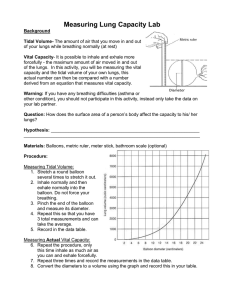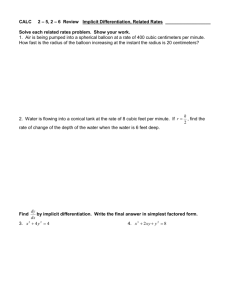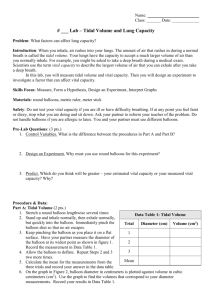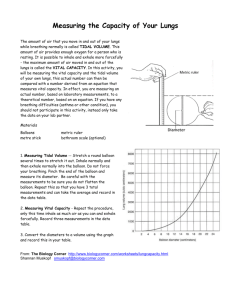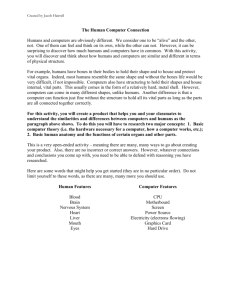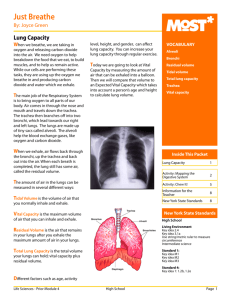Lung Capacity Lab
advertisement
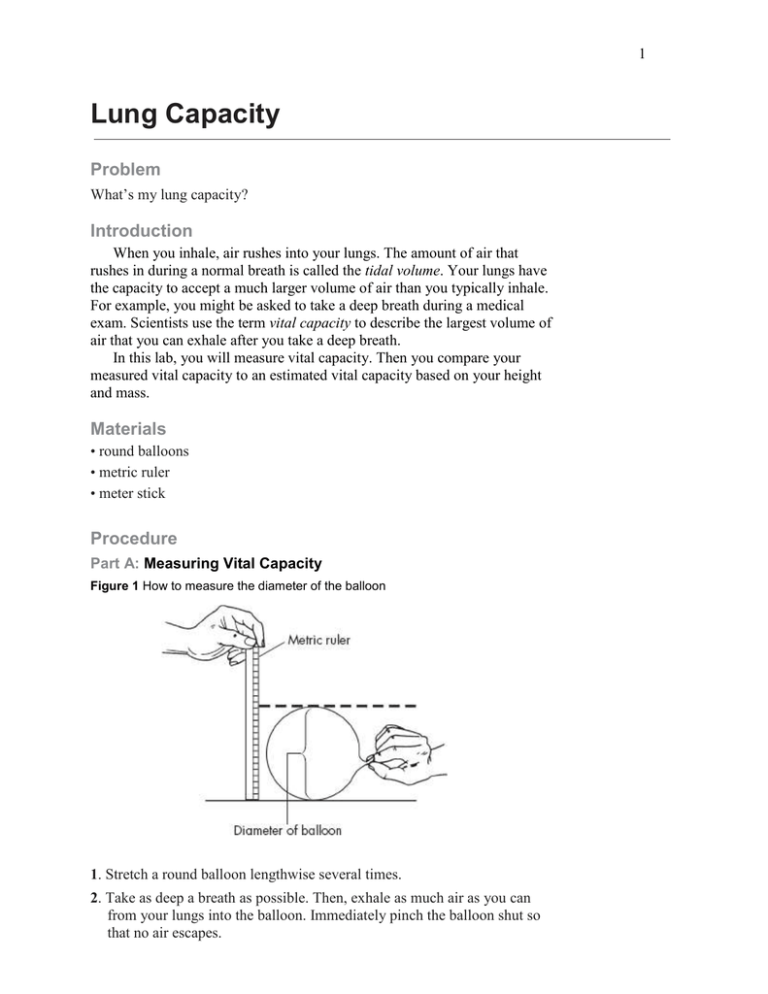
1 Lung Capacity Problem What’s my lung capacity? Introduction When you inhale, air rushes into your lungs. The amount of air that rushes in during a normal breath is called the tidal volume. Your lungs have the capacity to accept a much larger volume of air than you typically inhale. For example, you might be asked to take a deep breath during a medical exam. Scientists use the term vital capacity to describe the largest volume of air that you can exhale after you take a deep breath. In this lab, you will measure vital capacity. Then you compare your measured vital capacity to an estimated vital capacity based on your height and mass. Materials • round balloons • metric ruler • meter stick Procedure Part A: Measuring Vital Capacity Figure 1 How to measure the diameter of the balloon 1. Stretch a round balloon lengthwise several times. 2. Take as deep a breath as possible. Then, exhale as much air as you can from your lungs into the balloon. Immediately pinch the balloon shut so that no air escapes. 2 3. Keep pinching the balloon as you place it on a flat surface. Have your partner measure the diameter of the balloon at its widest point as shown in Figure 1 in centimeters. Record the diameter of the balloon in your notebook. 4. Allow the air out of the balloon. Then, repeat Steps 2 and 3 two more times. 5. Calculate the mean for the measurements from the three trials. Record the mean balloon diameter in your notebook. 6. On the graph in Figure 2, balloon diameter in centimeters is plotted against volume in cubic centimeters (cm3). Use the graph to find the lung volume that corresponds to your mean balloon diameter measurement from step 5. For example, if your mean balloon diameter measurement was 18 cm, your mean lung volume would be 3000 cm3. Record this value as your measured vital capacity. Figure 2 Lung volume versus balloon diameter Part B: Estimating Vital Capacity Research has shown that vital capacity is related to the surface area of a person’s body. You can estimate your surface area if you know your height and your mass. 7. You can use a meter stick to measure your height in centimeters or you can convert your height in inches to centimeters by multiplying the number of inches by 2.54. Record your height in cm in your notebook. Example: Let’s say you’re 5’3’’ first convert your height into inches 5’3’’ = 63 inches now convert your height in inches into centimeters 63 in x 2.54 cm/in = 160.02 cm 3 8. To convert your mass in pounds to kilograms, multiply the number of pounds by 0.454. Record your mass in kg in your notebook. Example: Let’s say you weigh 120 lbs convert your weight into kilograms 120 lbs x 0.454 kg/lbs = 54.48 kg 9. Use Figure 3 to estimate the surface area of your body. Find your height on the scale on the left. Find your mass on the scale on the right. Use a ruler connect those two points. The location where the ruler crosses the middle scale is your estimated surface area. Record your estimated surface area in your notebook. Example: If you are 160.02 cm tall and have a mass of 54.48 kg, your estimated surface area is 1.5 m2. Figure 3 Estimated surface area based on height and mass Get Ready! To calculate the estimated vital capacity of your lungs, you will multiply your surface area in square meters by the ratio of vital capacity to surface area. The ratio is 2000 cubic centimeters per square meter for females. In other words, in the next step, you will be multiplying your estimate from step 9 by 2000. 3 10. Estimated vital capacity = your surface area (m2) × 2000 cm m 2 Record your estimated vital capacity in your notebook. 4 Analyze and Conclude 1. Analyze Data How did your estimated vital capacity (answer from #10) compare with your measured vital capacity (answer from #6)? 2. Draw Conclusions What could have caused any difference between the estimated value and the measured value? 3. Design an Experiment Why is it important to do more than one trial when making measurements? 4. Predict How do you think smoking would affect lung capacity, and why? Analyze and Conclude 1. Analyze Data How did your estimated vital capacity (answer from #10) compare with your measured vital capacity (answer from #6)? 2. Draw Conclusions What could have caused any difference between the estimated value and the measured value? 3. Design an Experiment Why is it important to do more than one trial when making measurements? 4. Predict How do you think smoking would affect lung capacity, and why? Analyze and Conclude 1. Analyze Data How did your estimated vital capacity (answer from #10) compare with your measured vital capacity (answer from #6)? 2. Draw Conclusions What could have caused any difference between the estimated value and the measured value? 3. Design an Experiment Why is it important to do more than one trial when making measurements? 4. Predict How do you think smoking would affect lung capacity, and why? Analyze and Conclude 1. Analyze Data How did your estimated vital capacity (answer from #10) compare with your measured vital capacity (answer from #6)? 2. Draw Conclusions What could have caused any difference between the estimated value and the measured value? 3. Design an Experiment Why is it important to do more than one trial when making measurements? 4. Predict How do you think smoking would affect lung capacity, and why?
